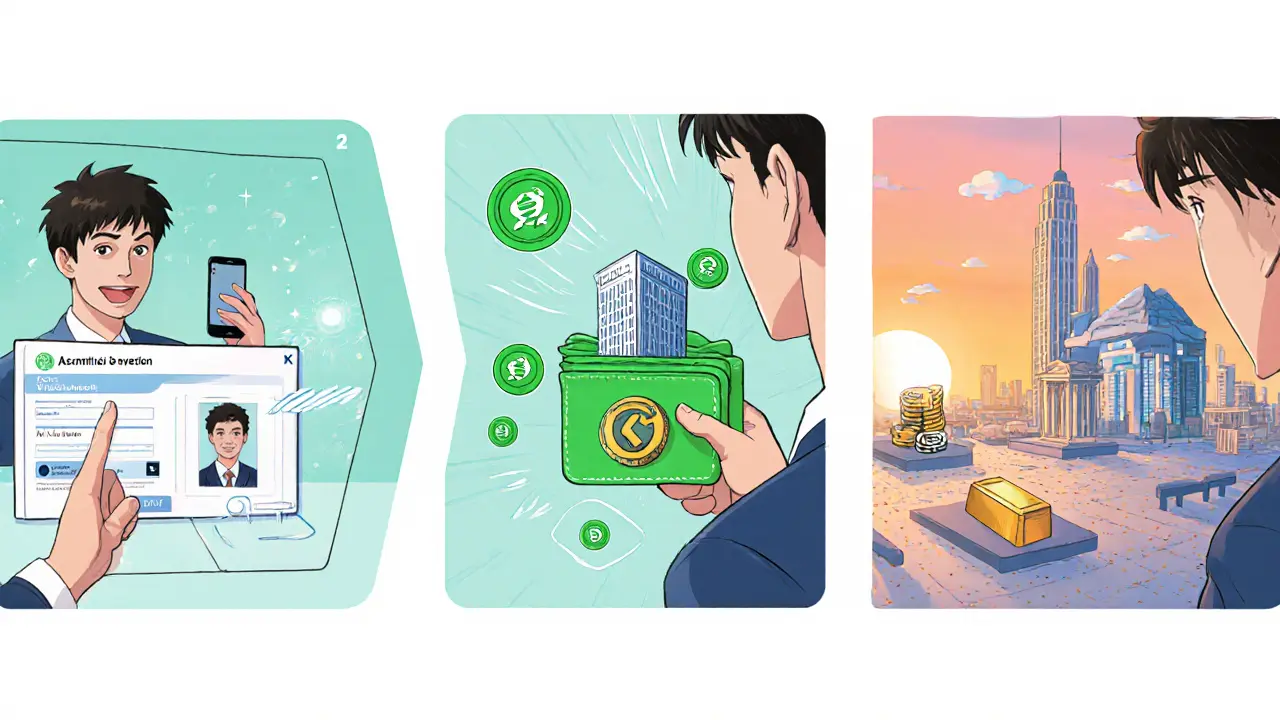Investing in Security Tokens: Step‑by‑Step Guide for 2025

Security Token Investment Calculator
Investment Estimator
Your Investment Summary
Enter your investment details to see your potential returns and allocation.
When investors talk about Security Token is a digitally issued security that represents ownership in a real‑world asset, fully compliant with securities regulations and recorded on a blockchain, they’re blending traditional finance with crypto tech. In 2025 the market has moved from experimental pilots to a mainstream option for anyone wanting exposure to real estate, equities, commodities, or even revenue streams-all through a single crypto‑friendly account.
Quick Takeaways
- Security tokens are regulated digital securities that live on blockchains like Ethereum.
- Start by choosing a compliant platform, complete KYC/AML, fund the account, and then browse tokenized assets.
- Fractional ownership lets you buy a slice of a $10million property with as little as $500.
- Always verify the platform’s jurisdictional coverage and built‑in compliance logic.
- Diversify across asset classes-real estate, equity, commodities-to manage risk.
What Is a Security Token?
A Security Token combines the legal protections of a traditional security with the speed and transparency of blockchain technology. Unlike utility tokens that grant access to a service, security tokens give you a legally recognized stake in an underlying asset. The token’s smart contract enforces rules such as who can hold it, how long it must be kept, and where it can be transferred.
Security Token Offering (STO) Basics
The fundraising event that creates these tokens is called a Security Token Offering a regulated capital‑raising method where issuers sell tokenized shares, real‑estate fractions, or other assets to qualified investors. An STO follows the same disclosure and registration requirements as a traditional securities offering, but the issuance and settlement happen on‑chain, usually within seconds.
Regulatory Landscape in 2025
The SEC’s 2025 guidance classifies any token that promises profit based on the efforts of a central team as a security. This means most STOs must comply with registration, prospectus, and investor‑qualification rules. In the United States, accredited investors-those with $1million in net assets or $200,000 annual income-are the default audience, though certain exemptions now let retail investors participate in smaller, fully‑disclosed offerings. The European Union’s MiCA framework, Singapore’s MAS licences, and the UAE’s DIFC regulations all carry similar eligibility checks. Understanding the jurisdiction you’re investing from is the first safety net.
Choosing the Right Platform
Not every crypto exchange can handle security tokens. Look for platforms that integrate on‑chain KYC/AML, programmable compliance, and custodial services. Below is a quick comparison of three leading platforms that focus on security‑token compliance.
| Feature | TokenBridge | ClearFunds | AssetChain |
|---|---|---|---|
| Primary Blockchain | Ethereum (ERC‑1400) | Ethereum (ERC‑1400) | Polygon (ERC‑1400) |
| KYC/AML Integration | Built‑in, automated on‑chain checks | Third‑party provider, manual review | Hybrid, optional off‑chain verification |
| Asset Variety | Real‑estate, equities, commodities | Equities, revenue‑share tokens | Art, IP, crypto‑backed loans |
| Custody Options | Institutional grade, insured | Self‑custody only | Hybrid (self + custodial) |
| Regulatory Coverage | US, EU, Singapore, UAE | US, Canada | EU, Australia |

Step1: Complete KYC and AML Verification
Every reputable security‑token platform forces you through a KYC Know Your Customer process that confirms your identity using government‑issued ID, proof of address, and sometimes a selfie video check. Simultaneously, an AML Anti‑Money‑Laundering screening that runs your name against sanctions and watch‑lists is performed. The whole flow usually takes 15‑30minutes if your documents are clear.
Step2: Fund Your Account
Once verified, you can add cash via bank transfer, wire, or an approved stable‑coin deposit (USDC or USDT). Most platforms lock fiat in an FDIC‑insured account, while crypto deposits stay in a segregated custodial wallet. Remember to check the platform’s fee schedule-bank wires tend to be cheaper than instant crypto bridges.
Step3: Browse Tokenized Assets
Now the real fun begins. Below are the three hottest asset classes for security‑token investors in 2025.
Tokenized Real Estate
A Tokenized Real Estate splits a property’s equity into digital tokens that can be bought, sold, or held like any other security. Example: a premium office building in Manhattan worth $50million is divided into 5million tokens, each representing a 0.001% stake. Investors receive quarterly rent distributions automatically via a smart‑contract dividend mechanism. Fractional ownership means you can own a piece of a skyscraper with as little as $250.
Tokenized Equity
Startups and mid‑size firms are issuing Equity Tokens digital shares that give holders voting rights, dividends, and the ability to trade 24/7 on secondary markets. Unlike a traditional IPO, an STO can close in weeks, and the token can be listed on both a regulated exchange and a decentralized venue. This dual‑listing boosts liquidity for early investors.
Tokenized Commodities & Others
Gold, silver, and even carbon credits are now issued as security tokens. A token tied to a barrel of oil automatically updates its value via an oracle, and the holder can sell the token whenever market hours are open-no need for a futures contract.
Step4: Purchase Your First Token
With funds in place, navigate to the asset’s detail page, enter the amount you wish to buy, and confirm the transaction. Because the token lives on Ethereum, the purchase settles in seconds and is recorded on the blockchain instantly. Most platforms let you set a limit order, so you can buy only when the price dips to your target.

Step5: Manage and Trade Your Portfolio
After purchase, the token appears in your dashboard alongside a real‑time valuation chart. You can:
- Receive automatic dividend payouts (for equity tokens) via Smart Contract self‑executing code that distributes cash or additional tokens without manual intervention.
- Set up stop‑loss or take‑profit alerts to protect gains.
- Transfer tokens to a custodian wallet if you plan to hold them long term.
- Sell on a secondary market - many regulated exchanges now support 24/7 trading of security tokens, eliminating the “closed‑out‑of‑hours” problem of traditional stock markets.
Risks and Best‑Practice Tips
Even though security tokens promise lower friction, they still carry traditional investment risks plus a few blockchain‑specific ones.
- Regulatory risk: Laws can change, affecting token eligibility or forcing delistings.
- Smart‑contract bugs: A flawed contract could freeze transfers. Stick to platforms that have undergone third‑party audits.
- Liquidity variance: Not every token trades heavily. Check average daily volume before committing large sums.
- Custody safety: If you hold tokens in a self‑custody wallet, protect your private keys with hardware wallets and multi‑factor authentication.
To mitigate these risks, diversify across at least three asset classes, keep a portion of your allocation in fully insured custodial accounts, and stay updated on regulatory news in your jurisdiction.
Future Outlook
The momentum behind security tokens shows no sign of slowing. Major exchanges like the NYSE parent’s Bakkt venture and the Swiss SIX Digital Exchange are launching dedicated security‑token markets, pulling billions of institutional dollars into the space. As compliance‑by‑design matures, we’ll see even retail‑friendly STOs for everyday assets like rental income streams or royalty payments. If you start now, you’ll be ahead of the curve when tokenization becomes the default way to invest in anything from a coffee shop to a multinational corporation.
Frequently Asked Questions
Can I buy security tokens with any cryptocurrency?
Most regulated platforms accept stablecoins like USDC or USDT for direct on‑chain deposits. Some also allow a fiat‑to‑crypto bridge, but native crypto such as Bitcoin is rarely accepted because it lacks built‑in compliance checks.
Do security tokens generate tax documents?
Yes. Because they are treated as securities, platforms provide year‑end statements similar to brokerage firms, detailing dividends, capital gains, and holding periods for your tax filings.
What’s the difference between a security token and a utility token?
A security token represents an ownership stake in a regulated asset and is subject to securities law. A utility token merely gives access to a product or service and is not considered a financial security.
How quickly can I sell a security token?
On compliant secondary exchanges, sales settle in seconds, same as any crypto transaction. However, some tokens have built‑in lock‑up periods that must expire before you can transfer them.
Do I need a broker to trade security tokens?
No traditional broker is required. The platform acts as both the broker and the custodian, handling compliance, settlement, and record‑keeping on‑chain.
Kim Evans
October 16, 2025 AT 09:26Great overview! The step‑by‑step breakdown makes it easy for newcomers to follow. Make sure to double‑check the KYC documents for clarity-mistakes there can delay verification. Also, keep an eye on platform fees; they can add up over time. Good luck with your first token purchase 🙂
Steve Cabe
October 16, 2025 AT 18:53America leads the world in financial innovation, and security tokens are no exception. The United States provides the most rigorous regulatory framework, ensuring investor protection. Platforms that comply with SEC guidance offer the highest standards of security. When you invest, prioritize U.S.-based exchanges to benefit from robust oversight. This approach safeguards your assets while supporting domestic growth.
shirley morales
October 17, 2025 AT 04:36Security tokens represent the future of capital markets. They fuse legal certainty with blockchain efficiency. Traditional investors demand compliance above all. The regulatory landscape of 2025 is unforgiving. Only platforms that embed KYC and AML can survive. Fractional ownership democratizes access to elite assets. A $500 stake in a ten‑million dollar property is now conceivable. However sophistication is required to navigate tokenomics. Investors must scrutinize smart contract audits. Neglecting due diligence invites unnecessary risk. Diversification across asset classes mitigates exposure. Liquidity considerations remain paramount. Custodial solutions must be insured and institutional grade. Regulatory compliance is not optional but a prerequisite. Embracing security tokens elevates one’s portfolio to a new echelon
Bruce Safford
October 17, 2025 AT 05:26Surely the article omits the hidden risk of state surveillance on token transactions. Every blockchain node can be traced back to a jurisdiction that may covertly share data with foreign agencies. The so‑called “compliance” could be a front for mass data harvesting. Investors should consider off‑chain alternatives to avoid this invisible trap. Also the audit reports are often fabricated to win marketing glory.
Blue Delight Consultant
October 17, 2025 AT 14:53One might contemplate the epistemic implications of tokenizing tangible assets. When ownership becomes a series of digits on a ledger, the very notion of property evolves. It is prudent to reflect upon the balance between liquidity and the intangible nature of digital certificates. Moreover, the regulatory scaffolding must be examined through the lens of justice and equity. A measured approach, albeit occasionally marred by typographical oversights, ensures sustainable participation.
Wayne Sternberger
October 17, 2025 AT 15:43Indeed, the philosophical perspective you raise is valuable. As a mentor I would advise newcomers to start with a modest allocation and use a hardware wallet for custody. This strategy reduces exposure while still allowing you to benefit from the evolving market. Remember that even the most formal platforms can have occasional typographical errors, but the underlying technology remains sound. Stay diligent and you will navigate the space confidently.
Gautam Negi
October 18, 2025 AT 01:26While the mainstream narrative glorifies security tokens as the next frontier, one must consider the possibility that the hype eclipses substantive value. The allure of fractional ownership can mask inherent inefficiencies in underlying assets. Moreover, the regulatory over‑engineering may stifle genuine innovation, leading to a sterile marketplace. It is worth questioning whether the promised liquidity truly materializes beyond the veneer of on‑chain immediacy.
Shauna Maher
October 18, 2025 AT 02:16Don't be fooled by elegant prose. The whole industry is a puppet show orchestrated by the financial elite to keep the masses dependent. Every token sale is pre‑approved by shadowy committees that decide who gets to profit. If you think this is about democratization, you're buying into a lie crafted by the power brokers.
Kyla MacLaren
October 18, 2025 AT 12:00Thanks for the detailed guide! I think it would be helpful to add a quick checklist for new users. Something like: verify KYC, compare fees, review token audit, and set up a secure wallet. This way folks can tick off steps and feel more confident.
Jim Greene
October 18, 2025 AT 12:33Excited to dive in and watch my portfolio grow 🚀